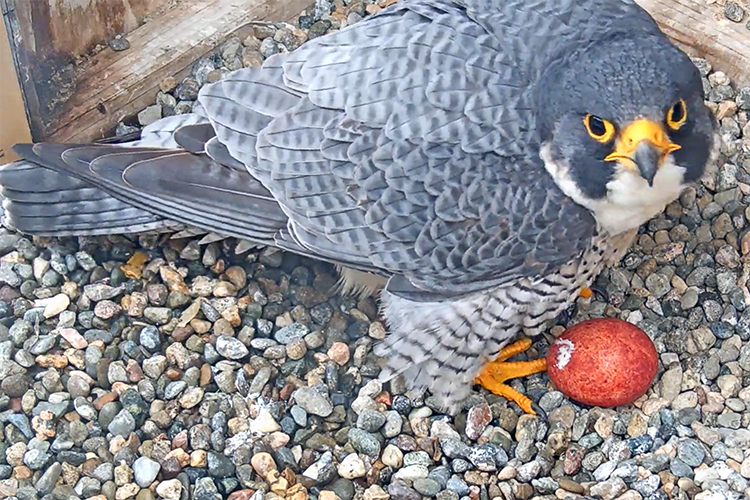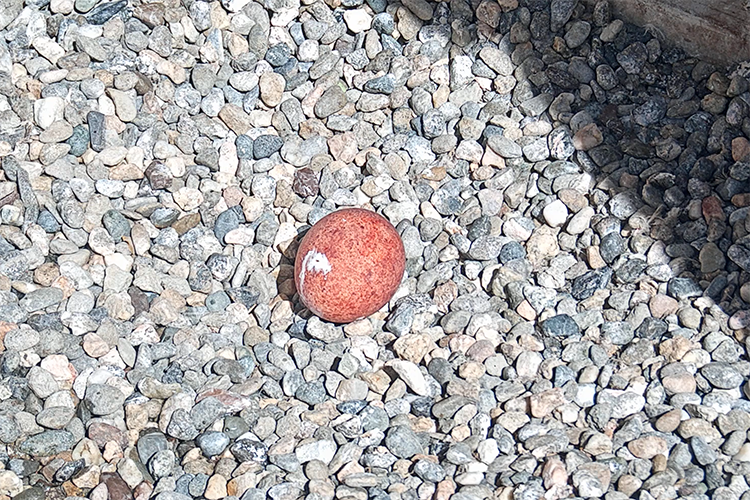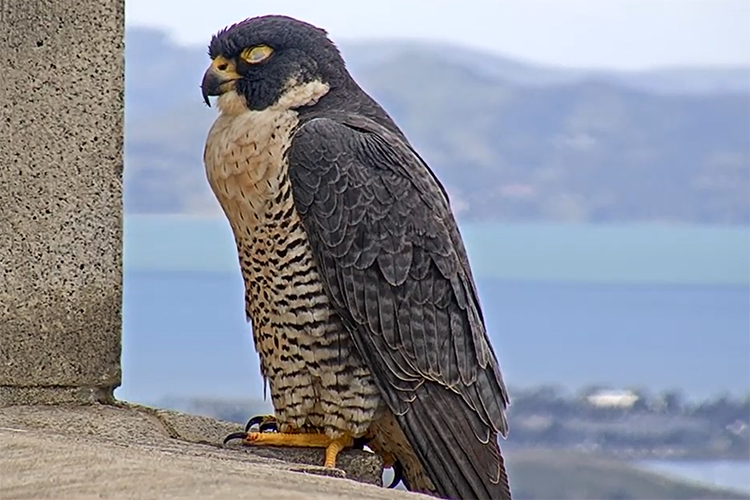First egg of 2021 arrives for UC Berkeley’s peregrine falcons
On Thursday, March 11, Cal Falcons will host a live Q&A session on YouTube about egg-laying season
March 10, 2021

The first egg of 2021 has arrived for Grinnell (pictured here), the male falcon on the Campanile, and his mate Annie. More eggs are expected in the next several days. (Cal Falcons image)
Veteran peregrine falcon mother Annie laid her first egg of 2021 early this morning in her gravel nest on UC Berkeley’s 307-foot-tall Campanile. Since then, she and her mate, Grinnell, have been seen taking turns incubating the egg — there are three 24/7 webcams on the tower, one on the nest — with Annie taking breaks to eat what Grinnell hunts.
This is the falcon pair’s fifth breeding season on the campus.
Fans of the beloved Berkeley falcons began tweeting excitedly shortly after the egg’s 1:55 a.m. arrival. There likely will be three more eggs laid over the next several days.
“Annie’s been reliably laying four eggs a year since the first year she was in the nest box,” said Sean Peterson, a Berkeley Ph.D. student who, with biologist Lynn Schofield, his wife, began a successful social media project — Cal Falcons — in 2019 to introduce the birds to a wide audience. Today, the falcons have fans in 45 countries who follow Cal Falcons posts on Instagram, Facebook and Twitter.

The white mark on the egg “is poop,” said Sean Peterson, who runs the Cal Falcons social media project with Lynn Schofield. “It will probably wash off, but may stain the egg a bit. If it does, it is actually kind of helpful for us, as we’ll be able to know which egg is the first one!” (Cal Falcons image)
Tomorrow (Thursday, March 11) at noon, Peterson and Schofield will host a live Q&A session about egg-laying season on YouTube. It will be the sixth Cal Falcons Q&A that the couple has offered since the coronavirus pandemic began. The prior Q&A sessions can be found here.
“The Q&As began because we were planning an educational event and programming for Cal Day 2020 and also for Hatch Day,” said Schofield. “Those were in-person events, so we pivoted to virtual ones” when the state’s shelter-in-place orders arrived.
Peterson said he and Schofield “will open the floor to anyone with questions about egg-laying and the breeding season.”
The falcons were first observed setting up a territory centered on the bell tower in December 2016 and, at first, they used a makeshift nest on a sandbag. To encourage successful nesting, researchers replaced the bag in 2017 with a nest box filled with gravel. Two eggs that were on the sandbag that year were moved to the new nest box.

Annie rests after laying her first egg at 1:55 a.m. on Wednesday, March 10. She also appeared to appreciate a special carillon concert yesterday. (Cal Falcons image)
So far, 10 chicks have been raised by Annie and Grinnell; one, Lux, died in July 2017 as a fledgling that flew into a window on the 10th floor of Evans Hall.
Annie was in the midst of laying eggs in 2020 when the campus closed to in-person instruction. Peterson and Schofield haven’t been in the tower since, as it’s locked to all but the University Carillonist Jeff Davis and three of his 10 students who live close enough to campus to use the practice rooms there.
Yesterday, Peterson said Annie seemed to be listening to a carillon concert given by Davis to mark the one-year anniversary of Berkeley switching to online instruction and closing all but the most essential on-campus operations. After the bells tolled the noon hour, a moment of silence was observed for the lives lost so far to COVID-19 – more than 2.5 million worldwide and some 500,000 in the U.S. alone.
“It was sweet to see her on campus for the whole concert,” he said. “She was listening and napping on one of the ledges, and we zoomed in on her while the bells were playing.”